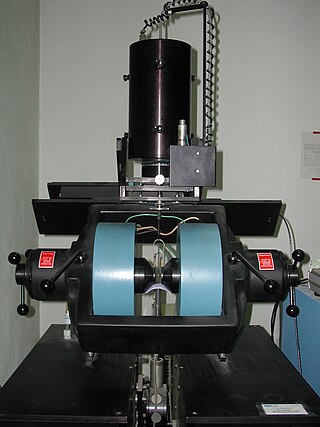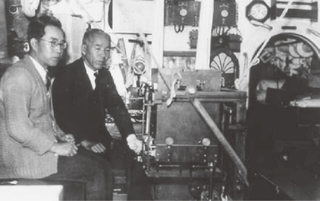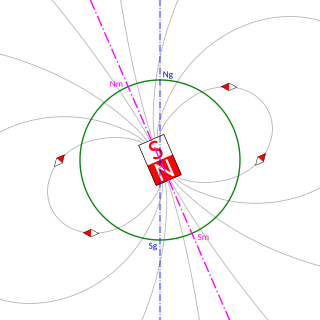Related Research Articles

Plate tectonics is the scientific theory that Earth's lithosphere comprises a number of large tectonic plates, which have been slowly moving since about 3.4 billion years ago. The model builds on the concept of continental drift, an idea developed during the first decades of the 20th century. Plate tectonics came to be accepted by geoscientists after seafloor spreading was validated in the mid-to-late 1960s.

Earth's magnetic field, also known as the geomagnetic field, is the magnetic field that extends from Earth's interior out into space, where it interacts with the solar wind, a stream of charged particles emanating from the Sun. The magnetic field is generated by electric currents due to the motion of convection currents of a mixture of molten iron and nickel in Earth's outer core: these convection currents are caused by heat escaping from the core, a natural process called a geodynamo.

Geochronology is the science of determining the age of rocks, fossils, and sediments using signatures inherent in the rocks themselves. Absolute geochronology can be accomplished through radioactive isotopes, whereas relative geochronology is provided by tools such as paleomagnetism and stable isotope ratios. By combining multiple geochronological indicators the precision of the recovered age can be improved.

Paleomagnetism is the study of magnetic fields recorded in rocks, sediment, or archeological materials. Geophysicists who specialize in paleomagnetism are called paleomagnetists.

Rock magnetism is the study of the magnetic properties of rocks, sediments and soils. The field arose out of the need in paleomagnetism to understand how rocks record the Earth's magnetic field. This remanence is carried by minerals, particularly certain strongly magnetic minerals like magnetite. An understanding of remanence helps paleomagnetists to develop methods for measuring the ancient magnetic field and correct for effects like sediment compaction and metamorphism. Rock magnetic methods are used to get a more detailed picture of the source of the distinctive striped pattern in marine magnetic anomalies that provides important information on plate tectonics. They are also used to interpret terrestrial magnetic anomalies in magnetic surveys as well as the strong crustal magnetism on Mars.
Allan Verne Cox was an American geophysicist. His work on dating geomagnetic reversals, with Richard Doell and Brent Dalrymple, made a major contribution to the theory of plate tectonics. Allan Cox won numerous awards, including the prestigious Vetlesen Prize, and was the president of the American Geophysical Union. He was the author of over a hundred scientific papers, and the author or editor of two books on plate tectonics. On January 27, 1987, Cox died in an apparent suicide.
A geomagnetic reversal is a change in a planet's magnetic field such that the positions of magnetic north and magnetic south are interchanged. The Earth's field has alternated between periods of normal polarity, in which the predominant direction of the field was the same as the present direction, and reverse polarity, in which it was the opposite. These periods are called chrons.
Archaeomagnetic dating is the study and interpretation of the signatures of the Earth's magnetic field at past times recorded in archaeological materials. These paleomagnetic signatures are fixed when ferromagnetic materials such as magnetite cool below the Curie point, freezing the magnetic moment of the material in the direction of the local magnetic field at that time. The direction and magnitude of the magnetic field of the Earth at a particular location varies with time, and can be used to constrain the age of materials. In conjunction with techniques such as radiometric dating, the technique can be used to construct and calibrate the geomagnetic polarity time scale. This is one of the dating methodologies used for sites within the last 10,000 years. The method was conceived by E. Thellier in the 1930s and the increased sensitivity of SQUID magnetometers has greatly promoted its use.

Edward A. "Ted" Irving, was a geologist and scientist with the Geological Survey of Canada. His studies of paleomagnetism provided the first physical evidence of the theory of continental drift. His efforts contributed to our understanding of how mountain ranges, climate, and life have changed over the past millions of years.

Motonori Matuyama was a Japanese geophysicist who was the first to provide systematic evidence that the Earth's magnetic field had been reversed in the early Pleistocene and to suggest that long periods existed in the past in which the polarity was reversed. He remarked that the Earth's field had later changed to the present polarity. The era of reversed polarity preceding the current Brunhes Chron of normal polarity is now called the Matuyama Reversed Chron; and the transition between them is called the Brunhes–Matuyama or Matuyama-Brunhes reversal.
Natural remanent magnetization is the permanent magnetism of a rock or sediment. This preserves a record of the Earth's magnetic field at the time the mineral was laid down as sediment or crystallized in magma and also the tectonic movement of the rock over millions of years from its original position. Natural remanent magnetization forms the basis of paleomagnetism and magnetostratigraphy.

In geology, a rock's fabric describes the spatial and geometric configuration of all the elements that make it up. In sedimentary rocks, the fabric developed depends on the depositional environment and can provide information on current directions at the time of deposition. In structural geology, fabrics may provide information on both the orientation and magnitude of the strains that have affected a particular piece of deformed rock.
Magnetostratigraphy is a geophysical correlation technique used to date sedimentary and volcanic sequences. The method works by collecting oriented samples at measured intervals throughout the section. The samples are analyzed to determine their characteristic remanent magnetization (ChRM), that is, the polarity of Earth's magnetic field at the time a stratum was deposited. This is possible because volcanic flows acquire a thermoremanent magnetization and sediments acquire a depositional remanent magnetization, both of which reflect the direction of the Earth's field at the time of formation. This technique is typically used to date sequences that generally lack fossils or interbedded igneous rock. It is particularly useful in high-resolution correlation of deep marine stratigraphy where it allowed the validation of the Vine–Matthews–Morley hypothesis related to the theory of plate tectonics.
Geomagnetic secular variation refers to changes in the Earth's magnetic field on time scales of about a year or more. These changes mostly reflect changes in the Earth's interior, while more rapid changes mostly originate in the ionosphere or magnetosphere.
Apparent polar wander (APW) is the perceived movement of the Earth's paleomagnetic poles relative to a continent while regarding the continent being studied as fixed in position. It is frequently displayed on the present latitude-longitude map as a path connecting the locations of geomagnetic poles, inferred at distinct times using paleomagnetic techniques.
Plate reconstruction is the process of reconstructing the positions of tectonic plates relative to each other or to other reference frames, such as the Earth's magnetic field or groups of hotspots, in the geological past. This helps determine the shape and make-up of ancient supercontinents and provides a basis for paleogeographic reconstructions.

The geomagnetic poles are antipodal points where the axis of a best-fitting dipole intersects the surface of Earth. This theoretical dipole is equivalent to a powerful bar magnet at the center of Earth, and comes closer than any other point dipole model to describing the magnetic field observed at Earth's surface. In contrast, the magnetic poles of the actual Earth are not antipodal; that is, the line on which they lie does not pass through Earth's center.
Paleolightning refers to the remnants of ancient lightning activity studied in fields such as historical geology, geoarchaeology, and fulminology. Paleolightning provides tangible evidence for the study lightning activity in Earth's past and the roles lightning may have played in Earth's history. Some studies have speculated that lightning activity played a crucial role in the development of not only Earth's early atmosphere but also early life. Lightning, a non-biological process, has been found to produce biologically useful material through the oxidation and reduction of inorganic matter. Research on the impact of lightning on Earth's atmosphere continues today, especially with regard to feedback mechanisms of lightning-produced nitrate compounds on atmospheric composition and global average temperatures.

Crustal magnetism is the magnetic field of the crust of a planetary body. The crustal magnetism of Earth has been studied; in particular, various magnetic crustal anomalies have been studied. Two examples of crustal magnetic anomalies on Earth that have been studied in the Americas are the Brunswick magnetic anomaly (BMA) and East Coast magnetic anomaly (ECMA). Also, there can be a correlation between physical geological features and certain readings from crustal magnetism on Earth. Below the surface of the Earth, the crustal magnetism is lost because the temperature rises above the curie temperature of the materials producing the field.
Subir Kumar Banerjee is an Indian-American geophysicist, known for research on rock magnetism, palaeomagnetism, and environmental magnetism.
References
- 1 2 3 4 5 6 Robert F. Butler, PaleomagnetismMagnetic Domains to Geologic Terranes, 1992, Chapter 7: Paleomagnetic poles
- ↑ Dieke Gerritsen, Bram Vaes, Douwe J. J. van Hinsbergen, "Influence of Data Filters on the Position and Precision of Paleomagnetic Poles: What Is the Optimal Sampling Strategy?", doi : 10.1029/2021GC010269